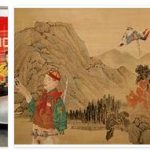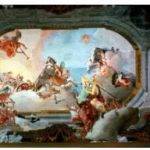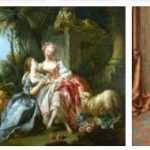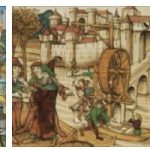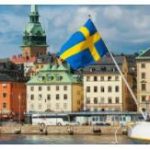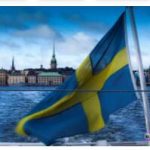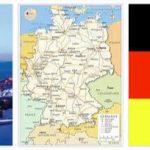Architecture
The first period of the century is determined by national romanticism and material realism. The Engelbrekts Church (1909–14) by Lars Israel Wahlman (* 1870, † 1952) and the town house (1911–23) on Mälaren by R. Östberg form an independent synthesis of local brick construction and international architecture. Evidence of international neoclassicism emerged after the First World War: Konzerthaus in Stockholm (1923–26) by Ivar Tengbom (* 1878, † 1968); Art Museum in Gothenburg (1919–23) by S. Ericson and Arvid Bjerke (* 1880, † 1952). The buildings by G. Asplund are located between neoclassicism and functionalism, which experienced its major breakthrough during the Stockholm Exhibition in 1930 (City Library, Stockholm, 1927, town hall extension, Gothenburg, 1935–37).
During and after the Second World War, Swedish architecture focused on building apartment buildings and homes, as well as planning suburban settlements and satellite towns. Still alive in the architecture of Sweden, in which the timber construction v. a. A cultivated classicist functionalism plays a role in residential construction, following in the footsteps of G. Asplund and his pupil and colleague Sigurd Lewerentz (* 1885, † 1975) and, especially in industrial construction, of O. Almqvist . R. Erskine was able to realize his socio-culturally determined settlement building in the settlement Nya Bruket in Sandviken (1972-88). In the 1990s, the architecture firm “Erséus, Frenning & Sjögren” made a name for itself with numerous award-winning designs (including Göteborg, Handelshochschule, 1992–95; Stockholm, Erikdalsbad, 1997–99). The Swedish architecture of the 90s is characterized by urban renewal projects such as B. the redesign of former industrial or military areas (including Norra Älvstranden, Gothenburg, 1980s / 90s; Stumholmen, Karlskrona, 1989–97).
Plastic
The leading sculptor in the first half of the 20th century was C. Milles (Poseidon Fountain in front of the Art Museum in Gothenburg, 1925–30; Orpheus Fountain in front of the Stockholm Concert Hall, 1930–36). Later, the sculptors of a younger generation worked with both natural and abstract forms (Bror Marklund, * 1907, † 1977; Bror Hjorth, * 1894, † 1968), some concentrated on problems of form. The productions by Dick Bengtsson (* 1936, † 1989) are characterized by mystery and irony. In the 1970s, Lars Kleen (* 1941) moved from the picture to the relief to wooden installations. Anette Stengård (* 1965) and Håkan Berg (* 1958) emerged with series of objects and experimental arrangements following Fluxus and Minimal Art. Annika Eriksson (* 1956) addresses the relationship between art production and art reception in her installations. Eva Löfdahl (* 1953), Stig Sjölund (* 1955) and Max Book (* 1953) appear as the »Neue Wilde«. – At the end of the 20th century, the traditional three-dimensional term was partly canceled in the installation. Media-related art, which examines communicative processes, plays v. a. in the works of David Krantz (* 1965), Anna Bring (* 1955) and Agneta Werner (* 1952) a role. In the field of complex multimedia art, among others, Fredrik Wretman (* 1953) and Ann-Sofie Sidén (* 1962).
Painting
Classic modernism was founded by painters who lived in Paris before the First World War. a. studied with H. Matisse (I. Grünewald; Sigrid M. Hjertén; Nils von Dardel, * 1888, † 1943). Also cubism (Gösta Adrian-Nilsson, called GAN, * 1884, † 1965;Kurt Jungstedt, * 1894, † 1963), surrealism (Sven Jonson, * 1902, † 1981; Stellan Mörner, * 1896, † 1979) and the New Objectivity (including Arvid Fougstedt, * 1888, † 1949) found followers. Inspired by functionalism z. B. a purist like Torsten Jovinge (* 1898, † 1936). After the Second World War, Swedish painting became partly non-representational (e.g. O. Baertling), partly a naive expressionism (Sven Erixson, * 1899, † 1970) or colorism (Carl Kylberg, * 1878, † 1952; Inge Schiöler, * 1908, † 1971, among others). In the field of abstract painting, Olle Bonnier (* 1925, † 2016) and Lage Lindell (* 1920, † 1980) emerged. In the present, all modern trends are represented. Photorealism has been relevant since the 1960s / 70s (John-E. Franzén, * 1942; Ola Billgren, * 1940, † 2001). Helene Billgren (* 1952), Carin Carlsson (* 1961) and Karin Mamma Andersson (* 1962) represent a figurative painting that ranges from photo-realistic still lifes or scenarios to gestural rendering and ironic parody of everyday clichés. Kerstin Winberg (* 1949), Torbjörn Limé (* 1963) and Mats Holgersson (* 1953) follow a more experimental direction. Lars Nilsson (* 1956) and Leonard Forslund (* 1959) deal with the question of how the process of becoming aware, among other things. takes place in mass media culture.
In the field of photography, inter alia Carl Gustaf Rosenberg (* 1883, † 1957) with landscapes and cultural monuments, Karl Sandels (* 1906, † 1986) with reportage photography, Yngve Baum (* 1945) v. a. with socially committed documentary photography, Christer Strömholm (* 1918, † 2002) and Sune Jonsson (* 1930, † 2009) v. a. with portraits.
Folk art
According to franciscogardening, from time immemorial there has been a specific folk art in Sweden, which was cultivated in various provincial forms until the 19th century and which has retained its character, even if it repeatedly assimilated impulses from the higher classes. Furniture and equipment were provided with carved or painted decorations made of tendrils and flowers, and a colorful textile art developed landscape-specific patterns and techniques (including folk costumes). The rural wallpaper and wall hanging painting of the 18th and 19th centuries with biblical motifs also testify to the decorative talent. The still existing, firmly organized home industry (Hemslöjd) adopted its techniques and motifs from folk art, but also developed them further.


